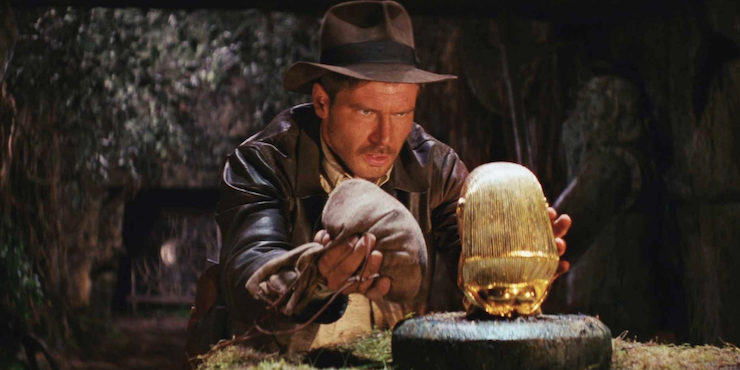Indiana Jones isn’t that bad of an archaeologist.
I mean, okay, the low relative quality of his archaeological expeditions is so notorious it’s become a bit of a truism. There’s a great McSweeney’s list of the reasons Herr Doktor Jones was denied tenure. Even as I make this argument, I can hear friends of mine who spent their summers on digs cringe inside, across the continent. (Hi, Celia!) But hear me out. This won’t take long.
(Looks at rest of essay)
Um. Maybe it will. Keep reading anyway.
First, I want to acknowledge the common protests. Jonesian archaeology looks a lot different from the modern discipline. If Jones wanted to use surviving traces of physical culture to assemble a picture of, say, precolonial Peruvian society, he’s definitely going about it the wrong way. Jones is a professional fossil even for the mid-30s—a relic of an older generation of Carters and Schliemans. Which, if you think about it, makes sense. By Raiders, he already has tenure, probably gained based on his field work in India (Subterranean Thuggee Lava Temples: An Analysis and Critical Perspective, William & Mary Press, 1935), and the board which granted him tenure were conservatives of his father’s generation, people who actually knew Carter and Schliemann—not to mention Jones, Sr. (I’ll set aside for the moment a discussion of cronyism and nepotism, phenomena utterly foreign to contemporary tenure review boards…)
Jones is the last great monster of the treasure-hunting age of archaeology. To judge him by modern standards is to indulge the same comforting temporal parochialism that leads us to dismiss post-Roman Europe as a “Dark Age.” Jones may be a lousy archaeologist as we understand the field today. But is he a lousy archaeologist in context?
To answer this question, we must evaluate the tasks Jones sets for himself—or the tasks set for him. Often Jones seeks an object smaller than a standard sea chest, with at best a vague sense of its location. In most cases the object is regarded by the brightest minds of the field to be mythical. Nor are these objects hiding just out of sight—in Raiders, Jones searches for the Ark of the Covenant, which his mentor, Dr. Ravenwood, pursued for his entire career without success—and finds it in less than a month. In Crusade, Jones finds the Holy Grail. Yes, he uses his father’s grail diary to get there—but, then, Henry Jones Sr. had that diary, and he didn’t find the Grail himself.
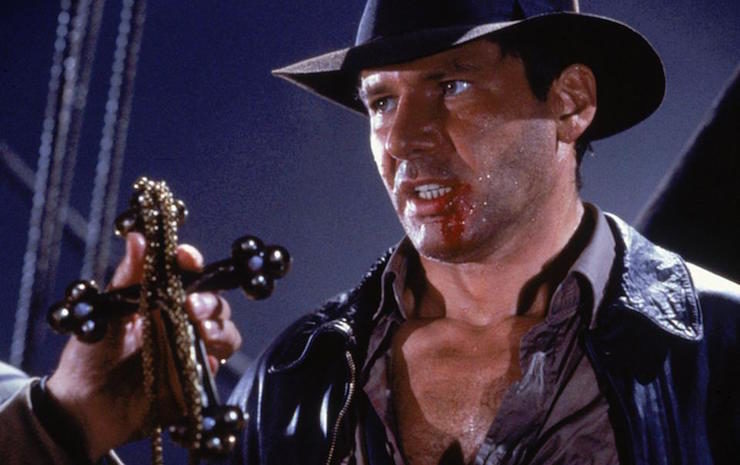
In each of the first three films (I have not seen Crystal Skull. Maybe I should?) Jones pursues two legendary objects, with a presumed goal of delivering each to a museum—one in the opening act, and another in the main plot. That gives us six data points: the idol head, the Ark of the Covenant, the ashes of Nurhachi, the Siva Stones, the Cross of Coronado, and the Holy Grail. Only the Cross actually makes it to the museum, which leaves Jones with a 16.7% success rate, but he does locate each object he sets out to find. If we ignore the Siva Stones, which Jones seems to have always planned to return to the village from which they were stolen, Jones’ success rate at converting “this object is probably mythical” into “this object is part of a publicly accessible museum collection” rises to one in five. His methods may be unorthodox by modern standards, but 20% is a lot higher than average, considering that we remember the names of archaeologists who do this even once.
Having addressed the question of his success at his own goals, let’s turn to some common complaints against Jones. Outstanding among these is the assertion that any of the death traps Jones casually subverts would be worth a great deal more to archaeology than the objects he sets out to recover. How many actual working pressure-sensitive blow gun traps do we have from Pre-Colombian Peru?
This is the strongest challenge to Jones’ methods, and to respond I’ll resort to a kind of movie logic, which pains me, but here we are. It’s hard to ignore that the Jones universe clearly differs in small but important ways from our own—consider, for example, the existence of magic, or the fact that a rubber raft can double as a parachute. The death traps Jones subverts would be archaeological fascinations in our world, where such things don’t exist (outside of Qin Shihuang’s tomb, perhaps) and would in fact be an amazing discovery. But they clearly do exist in Jones’ world, and are quite common.
Consider the case of the Peruvian tomb, in which Jones tries to defeat each trap in sequence. Either he discovered a description of the tomb’s traps, which suggests that Jones expected any extant traps to be functional, suggesting in turn that Jones possesses an overabundance of caution (hah!) or a history of encountering just such death traps—or he had a general sense of what traps are commonly used in tombs, even when those traps have no easily-deduced mechanism. (Like the beam of light-spear trap in Raiders—seriously, how the hell does that work? The ancients seem to have had an excellent command of optics.) In either case, we’re forced to admit that active death traps in Jones’ universe are a common concern for archaeologists, on the borderline between nuisance and real danger. Perhaps a wave of archaeologists in the Indiana Jones Universe’s 1970s will earn tenure as a result of advances in the revolutionary field of death trap archaeology, much as the study of middens has become key to modern archaeology.
Another common challenge, more easily dismissed, is that Jones is a bad teacher. Let’s set aside for the moment the fact that it’s perfectly possible to be a successful researcher and a horrible teacher. We seldom see Jones in the classroom, but what we do see paints him as a terrific teacher. In, let’s remember, 1936, his class looks like this:
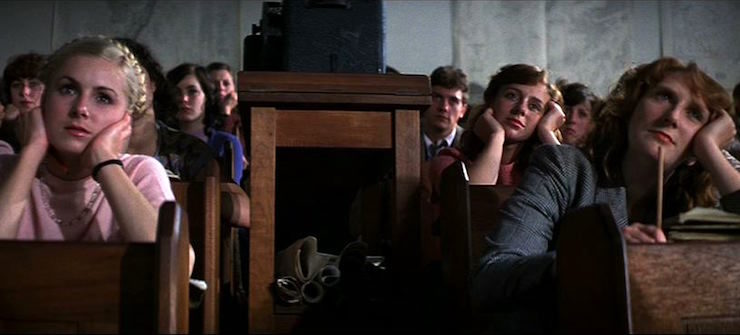
This is not what the classroom of a bad teacher looks like. Trust me. I’ve been a teacher, and when I started I was not a good one. This is especially not what the classroom of a bad teacher in 1936 looks like—look at that gender balance. Jones, who we’re led to believe works at an old-money institution, if not an Ivy than a near-Ivy, has a classroom of at least two-thirds women.
For contrast, my alma mater didn’t even admit women to its undergraduate program until the embarrassingly late year of 1969. And before you pass this gender balance off as a wartime phenomenon, we’re in ’36—Pearl Harbor’s a long ways away. The gender balance is such I might assume Marshall (Jones’ institution) to be a women’s college, but there are clearly male students, so we’re left to assume that Jones is a popular teacher, especially with female students. Suggesting all those women are in Jones’ class because they want to sleep with him—a common assertion—rejects out of hand the possibility that these women are legitimately excited about archaeology as Jones presents it, which seems like a skeevy and disrespectful move to me.
Granted, at least one student is romantically interested in Jones, which has led some viewers to the conclusion that Jones makes a habit of the kind of affairs that feature largely in the sort of novels certain English professors write about English professors. But Jones seems unsettled by his student’s romantic interest in him—and, while this draws aside form the main course of my argument, we see no evidence Jones is attracted to women over whom he has power.
Jones has three romantic engagements over three movies: Marion Ravenwood, whose introduction scene features her drinking a Sherpa under the table; Willie Smith, who may not be terribly well-prepared for bar fights and elephant rides but is a canny operator in her own right—it takes savvy for a farm girl to establish herself as Shanghai glitterati (Smith and Jones are actually a great pair, in a way: they both have chips on their shoulders the size of Texas, Smith’s discomfort with insects matches Jones’ discomfort with snakes, they have the same temper, etc.); and Ilsa, a hypercompetent archaeologist whose only weakness is that she happens to be a Nazi. Jones’ erotic interests appear consistent: he likes people who see him as a partner, a screw-up, or both. Which, of course, parallels his relationship with his father…and that’s as far as I’ll take this psychoanalytic sidebar. Let’s leave it here: people can behave in weird and bad and inconsistent ways, but I see no indication Jones is interested in affairs with his students.
Which leads me to the final point often used to argue that Jones isn’t a good (or representative) archaeologist, which tends to be that he’s too badass. Too hot. Too competent. Too adventurous. Archaeologists wear tweed. Archaeologists have glasses that make their eyes look bigger.
Bullshit.
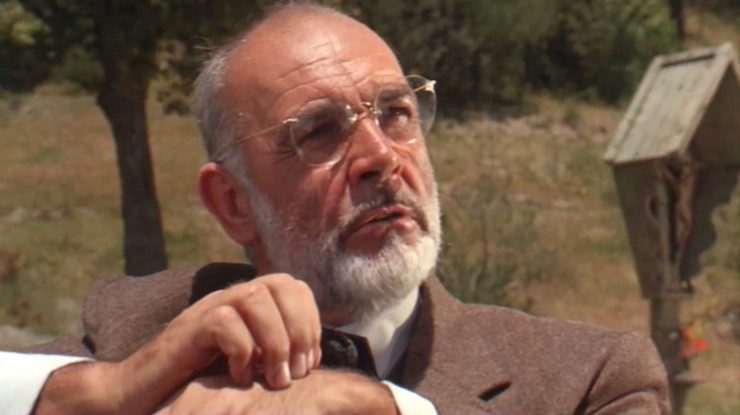
Let me tell you a story: in my 20s I met a young woman riding on the Mongolian steppe. I was part of a tour, on our third or fourth day out from base camp, feeling like a sack of potatoes in the saddle. She appeared at the summit of a ridge we were riding up: glint of sunlight on blonde hair under blue sky, moving as if born to the saddle. We hailed one another and paused to talk and share airag. She grew up in Montana, she said, around horses, and she had a few weeks off so she decided to go steppe riding by herself, and sleep under the stars. A few weeks off, said I. Where was she working?
At a dig, she replied, in the Gobi Desert. “There are abandoned cities all over the place out there,” she said. Then I asked her how I could stop feeling like a sack of potatoes in the saddle, and she taught me how to post.
This encounter set me afire with the dream of going back to school for central Asian archaeology. I investigated the idea and learned that in addition to the modern and Classical Chinese I already knew, I’d need at least a reading knowledge of French, German, Russian, Japanese, modern Mongolian, Sogdien which is a language I swear, Tangut, Uighur wouldn’t hurt, and at some point I’d have to pick up the Chinese character transliterations for Mongolian used in Yuan dynasty records. Then roughly seven years of PhD study in places where my girlfriend of seven years couldn’t follow—I’d have to surrender most of my friendships, and set aside writing as a serious pursuit. (All those languages!) But, God. Ancient cities in the desert.
Another anecdote: I’ve had wonderful professors, I’ve had brilliant professors, but without doubt the most badass professor I’ve ever had the pleasure to work with was Doctor Kimberly Bowes, a late classical archaeologist who spent a year teaching what amounts to introductory Mediterranean political science and history. Dr. Bowes knew a billion languages and she spent her fieldwork being lowered down pits into buried villages and subterranean temples of blood-drinking cults (I mean, Christian churches, but, you know, same diff). Having swallowed the “real archaeologists aren’t Indiana Jones” pill along with every skeptical kid my age, I thought she must be the exception, the Sole Awesome Archaeologist. Then a colleague of hers arrived one day to watch her class—he rode in on his motorcycle, with leather boots and a lanky figure and the kind of five-o-clock shadow actors pay people to help them fake.
And the stories I’ve heard from friends who’ve gone on fieldwork! Yes, it’s grids and dust and potsherds and toothbrushes, sure, but if you’ve ever camped out, and I mean really camped out, like a week in the mountains somewhere hiking ten miles a day kind of camping out—imagine doing that for months at a stretch, digging all day and working (or drinking, or both) all night. Imagine scars and shovel blisters and sweat and back pain and waking before dawn because you were so tired you went to sleep an hour after sundown. Imagine speaking three languages around a campfire. Imagine poisonous snakes on a thornbush-covered mountain at sunrise.
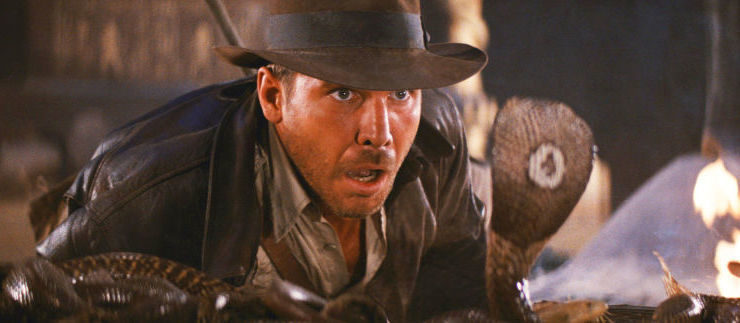
You know that bit in Firefly, where River says the cows forgot they were cows while they were inside a spaceship? If you’re reading this, I’ll hazard that your job takes place entirely inside the spaceship. Not so for an archaeologist who does fieldwork. That’s pretty awesome.
Indiana Jones isn’t that bad of an archaeologist at all, within his cultural and historical context. He’s a successful adventurer. He’s a popular teacher. And he, as per usual for archaeologists, is a badass. The real practice of archaeology doesn’t look much like the movies, no. But he’s far from the disaster he’s frequently envisioned to be.
This article was originally published in November 2014.
 Max Gladstone has been thrown from a horse in Mongolia, drank almond milk with monks on Wudang Shan, and wrecked a bicycle in Angkor Wat. Max is also the author of the Craft Sequence of books about undead gods and skeletal law wizards—the latest installment, Ruin of Angels, is available September 5th from Tor.com Publishing. You can follow him on Twitter.
Max Gladstone has been thrown from a horse in Mongolia, drank almond milk with monks on Wudang Shan, and wrecked a bicycle in Angkor Wat. Max is also the author of the Craft Sequence of books about undead gods and skeletal law wizards—the latest installment, Ruin of Angels, is available September 5th from Tor.com Publishing. You can follow him on Twitter.










